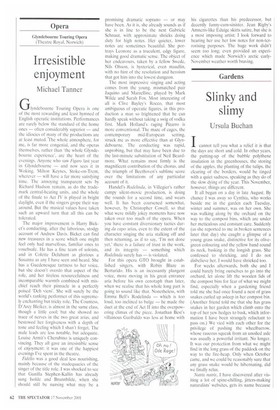Gardens
Slinky and slimy
Ursula Buchan
Icannot tell you what a relief it is that the days are short and cold. In other years, the putting-up of the bubble polythene insulation in the greenhouses, the storing of the apples, the planting of the tulips, the clearing of the borders, would be tinged with a quiet sadness, speaking as they do of the slow dying of the year. This November, however, things are different.
It all began on a day in late August. By chance I was away so Cynthia, who works beside me in the garden each Tuesday, winter and summer, was on her own. She was walking along by the orchard on the way to the compost bins, which are under her meticulous and constant care. Suddenly (as she reported to me in broken sentences later that day) she caught a glimpse of a young grass snake, distinctive for its olivegreen colouring and the yellow band round its neck, basking in the longish grass. She confessed to shrieking, and I do not disbelieve her. I would have shrieked too.
For weeks afterwards, both she and I could barely bring ourselves to go into the orchard, let alone lift the wooden lids of the compost bins for fear of what we might find, especially when a gardening friend told me she had once found a nest of grass snakes curled up asleep in her compost bin. (Another friend told me that she has grass snakes in her garden which climb onto the top of her yew hedges to bask, which information I have been strangely reluctant to pass on.) We vied with each other for the privilege of pushing the wheelbarrow, whose raucous squeak from an unoiled axle was usually a powerful irritant. No longer. It was our protection from what we might find in the long grass of the paddock on the way to the fire-heap. Only when October came, and we could be reasonably sure that any grass snake would be hibernating, did we finally relax.
Natrix natrix, I have discovered after visiting a lot of spine-chilling, jitters-making naturalists' websites, gets its name because
it likes to swim, and indeed is rarely found very far from water. We have no pond, as it happens, although we fully intend to dig one, once we can fish the idea out of the 'Too Difficult and Expensive' file where it presently resides. However, there is a farm ditch beyond our boundary, which periodically fills with water. and there are certainly plenty of sunny banks, long grass, rubbly stone walls, toads, frogs, small mammals and general lack of disturbance, all of which grass snakes like. And we have compost heaps, which are favourite places for them to lay eggs, being both warm and secure. Grass snakes hibernate between October and March, and lay eggs in June and July that hatch in August and September. Males can grow to 3ft, females to 5ft. It is likely that Cynthia saw a young one which had hatched in the pile of garden rubbish waiting to be composted.
She is adamant it was not a slow worm, which we may also, unwittingly, be harbouring in the garden. Slow worms have fewer markings and, as every schoolchild knows, are lizards without legs. However, the distinction is an idle, irrelevant one if, like Cynthia and me, you are herpetophobic.
Before you start thinking sly thoughts about women and snakes. I would just like to say that we are ladies of a certain age, who were brought up to think that snakes were nasty, slimy, slinky things, and we were not taken to zoos as children to be wreathed in writhing serpents, like Laocoon and his sons. That said, even the naturalists advise against handling grass snakes even though they are harmless — not only because they don't like the pressure, apparently, but because they show their displeasure by excreting a foulsmelling liquid all over you. No danger of that in this garden, I can assure you.
Of course, in a way we are both very pleased. The presence of snakes or lizards in the garden is proof that we have perpetuated, even if we have not created, an environment that suits wild creatures. For most of us, unless we are farmers or fieldsportsmen, gardening is the means by which we interact most intimately with nature. If we are sensible, we are happy neither to control that wildlife nor even know its every way. And we cannot possibly be fussy about what we foster. Although I am frightened of coming across a snake or slow worm, I am pleased that they choose to live here, especially as naturalists seem generally agreed that their numbers are in sharp decline.
Curiously, the more amphibian websites I visited, and the more colour photographs I studied, the less I feared to look on them. I was relieved, it is true, that lack of the appropriate software prevented me from seeing action film of a grass snake swimming, but in time I became almost inured to stills of curled-up serpents. Who knows. I may even get round to oiling that wheelbarrow axle some time in the next ten years. Whether Cynthia will ever be able to find a spare moment to tend the compost bins, come the spring, is another matter.
Ursula Buchan is latest book, Good in a Bed — Garden Writings from The Spectator, is published by John Murray (1 6.99)























































































 Previous page
Previous page